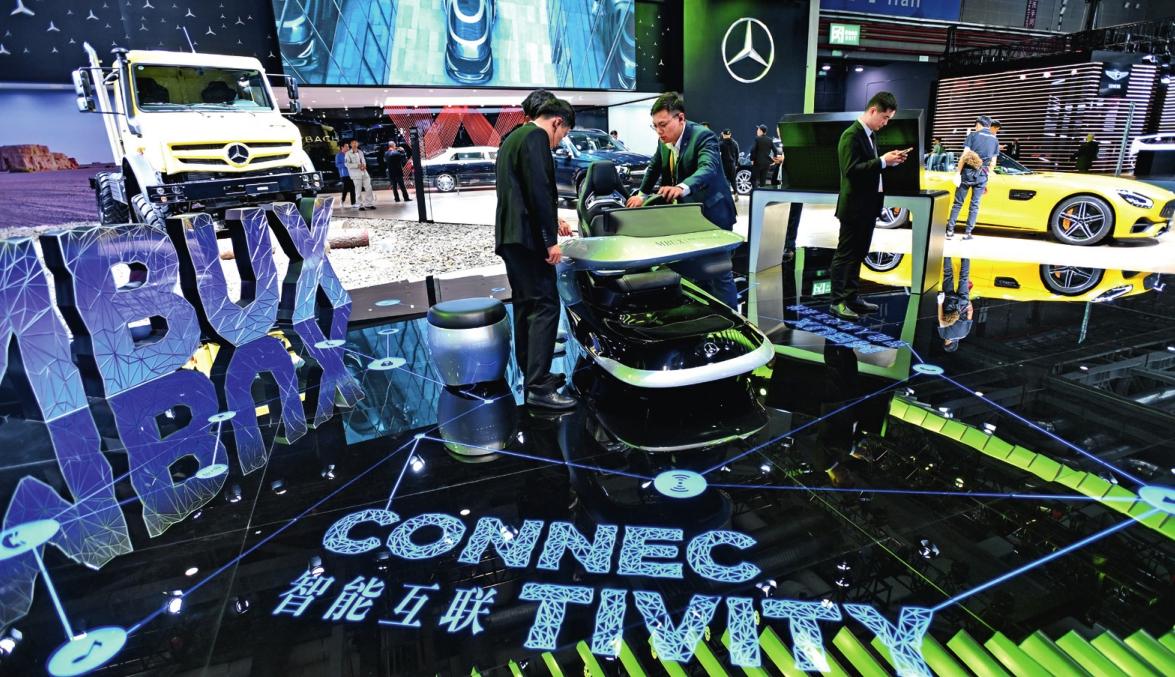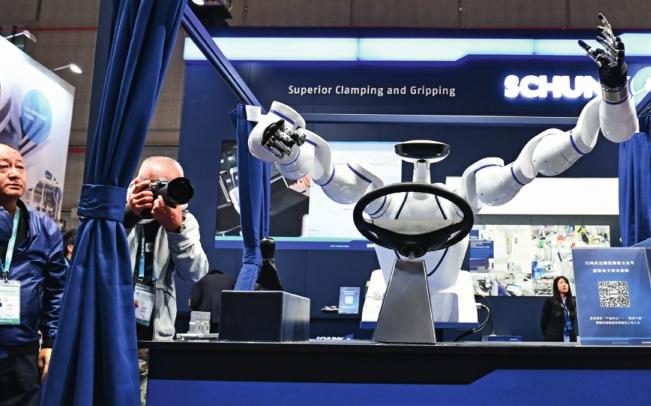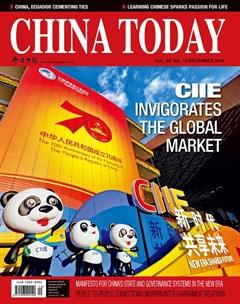High Technologies for a Better Life
By staff reporter ZHOU LIN

SMART home, intelligent transportation, service robots, and customized beauty instrument, all these hi-tech exhibits and services closely related to peoples daily life were the highlights showcased at the second China International Import Expo (CIIE).
Smart Elderly Care Home
Early in the morning, with the sound of singing birds and a gurgling brook, the soft light turns on while curtains are automatically turned up and the fragrance of lavender oil slowly permeates the bedroom. The first ray of sunshine filters in. “Its time to get up.” Panasonics smart home sends out its morning greeting.
A bleary-eyed master of the house stands in front of a washstand while looking into the “magic mirror”that tells them their sleep quality the night before and health data. The smart mirror also recommends appropriate fitness activities and a healthy diet for the day. Sitting on the close-stool, ones blood pressure and heart rate are shown on an electronic screen on the right side.
“I can physically experience and feel what my future home will look like. It is really worth waiting in such a long queue,” Huang Wei, a visitor who came all the way to Shanghai from Zhangjiagang City of Jiangsu Province, told China Today. “According to the Jiangsu Commission of Health, by the end of 2018, 20.2 percent of the population in the province were more than 60 years old, and it forecasts the percentage would exceed 30 percent by the year 2029. It would be a big challenge to meet the needs of caring for the elderly, nursing, geriatric rehabilitation and medical treatment then. We all have to prepare for the retirement life in advance,” Huang said.
As China is stepping into an aging society, a healthy and colorful life for the elderly is the pursuit of todays people. Providing a healthy and comfortable life for an aging Chinese society is the aim of Panasonics smart home.
At Panasonics smart home, the smart mirror identifies users through face recognition and displays vital data, analyzes their current physical condition, and provides health advice. A vital sign sensing toilet can measure muscle mass, heart rate, and body fat from the skin contact area, and also measure uric acid levels and other data from excreta. All this data is transferred through the weight-detection sensor beneath the washbasin and broadcast via the ceiling speakers.
“Many hi-tech details can be found in the bedroom, offering considerate services to users,” said Huang Wei. He was specifically impressed how the vital sign sensing bedroom ensures fast sleep through circadian lighting, and measures peoples heart rates while they are sleeping, as well as how it analyzes sleep depth and adjusts room tempera- ture automatically.

Panasonic also calculates the most comfortable indoor environment by controlling the temperature and air volume, improving the quality of the air flowing into the room by setting the total heat exchanger and air quality sensor. And it uses Wi-Fi networks to control air conditioners and lighting with smart switches and smart-phones to create a more comfortable and energy-efficient living space.
“During the six days of the first CIIE, more than half a million visitors came to our exhibition booth, and 102 companies showed their intention for sealing a trade deal. The effect was amazing,” President of Panasonic Electric Northeast Asia Company Homma Tetsuro said. This year, Panasonic expanded its booth to over 1,000 square meters, 300 square meters larger than that of last year. “We hope to display our best products to Chinese consumers at the second CIIE.”
Zero-Emission Vehicles
Food, clothing, home, and transportation are four basic necessities of life. After touring around the smart home, the reporter came to the automobile exhibition area to see the futurist cars. At the Hyundai Motors booth, two long queues of visitors were waiting for a test drive with a pair of VR glasses, during which they could obtain a 360-degree comfortable driving experience and learn more about the advanced technology of hydrogen-powered fuel cells.
H-Space is a cockpit for future mobile travel. Using a big data platform, H-Space can analyze the facial expression of the driver and adjust the light to help them relax. The crystal OLED smart window with display screen on ensures that the driver can receive driving information on time while enjoying the scenery outside. H-Space divides the inner space into three movable types — ME, US, and BEYOND, which can respectively meet the need of an individual, or two or more persons and their interactive experience.
In big cities like Beijing, residents often get frustrated by traffic jams. In May this year, Beijings first exclusive lane for bicycles connecting Huilongguan, one of the capitals most populous residential zones in Changping District, with Shangdi, a rapidly developing hi-tech industrial zone in neighboring Haidian District, became accessible for commuters. The creation of the e-scooter and e-bike is Hyundai Motors solution for the crux of “the last kilometer,” which can be folded up and put inside the vehicles and charged by the power generated in the vehicle while driving.
In an era when green driving has become popular among Chinese people, the fuel cell system is usually the most critical part of a car. At the Hyundai Motor exhibition area, there was a streamlined concept truck named NEPTUNE which was inspired from the railway carriage in the 1930s. This old-fashion but future-oriented large hydrogen fuel moving tool showcases how the leading technology of hydrogen fuel cells has expanded to commercial vehicles. This also further consolidates Hyundais leading position in hydrogen fuel cells.
“China is now in the leading position in big data analysis, artificial intelligence, and financial technology, playing a crucial role in the future industries. That is why Hyundai has chosen to display its cutting-edge technology in hydrogen fuel cells,” remarked Sae Hoon Kim, head of the fuel cell business department of Hyundai Motor, “We would like to convey to Chinese visitors our reflections and practice on sustainable development for the Chinese society via products of new energy and environment protection.”
Breathing on Your Skin
In the medical device exhibition area, the American top skincare brand Johnson & Johnson unveiled its most personalized skincare product – Neutrogena 3D-printed MaskiD, a sheet mask with six sections targeting different facial areas, able to make 5,000 types of customized pieces.
“Every mask is unique to itself,” said Dr. Michael Southall, Global R&D Lead at Johnson & Johnson Consumer Inc. “Using a smartphone 3D camera, the user simply snaps a selfie to create a precise, multidimensional map of her face and the exact measurements and shape of her nose, space between the eyes, lips, and other unique physical characteristics. Next, personalized data from the Neutrogena Skin 360 system creates the virtual equivalent of a knowledgeable dermatologist and analyzes the skins needs, making a recommendation for what ingredients will be most beneficial and where they should be applied. For example, the blue color of the mask represents the hyaluronic acid that can moisturize and nourish your skin; while purple color represents the glucosamine that helps relieve faint lines. Finally, facilitated by a proprietary 3D printing process, highefficacy ingredients are printed onto the customfit mask on the exact zones of the mask where they will deliver the greatest benefit for that individual.”
In the quality life exhibition area, the largest cosmetic group of South Korea AmorePacific showcased its second-generation 3D-printed mask introduced by IOPE, the companys own brand. General manager of Chinas marketing department of AmorePacific Gao Xin said, “It took 20 minutes to print a first-generation mask, while the secondgeneration mask only takes five minutes with T and U sections divided to meet different needs of customers.”
China has become the biggest overseas market of AmorePacific, accounting for 20 percent of its global market. “Chinas cosmetics market is booming, having become the worlds second largest,” said Gao Xin, “And Chinese consumers requirements tend to be more personalized.”
Wang Bingnan, Chinas Vice Minister of Commerce, indicated during the second CIIE that Chinas consumption demand is rapidly changing from quantity growth to being more quality-oriented. High-quality, individualized, and customized products are in high need. A new consumption model which is more innovative, green, smart, sharing, and customized is much more popular now.

